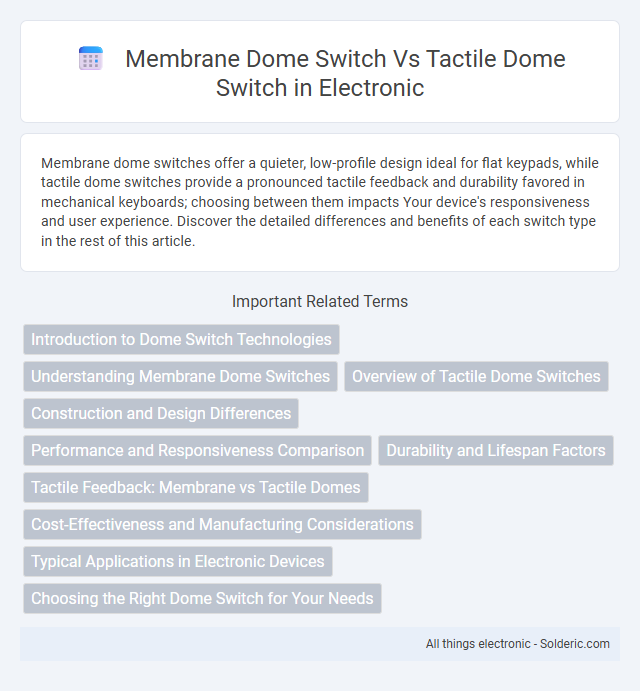Membrane dome switches offer a quieter, low-profile design ideal for flat keypads, while tactile dome switches provide a pronounced tactile feedback and durability favored in mechanical keyboards; choosing between them impacts Your device's responsiveness and user experience. Discover the detailed differences and benefits of each switch type in the rest of this article.
Comparison Table
| Feature | Membrane Dome Switch | Tactile Dome Switch |
|---|---|---|
| Construction | Flexible membrane with embedded dome-shaped contacts | Metal or plastic domes placed under keys for tactile feedback |
| Tactile Feedback | Soft, less pronounced feedback | Distinct, tactile "click" sensation |
| Durability | Moderate lifespan, prone to wear over time | Higher durability with longer lifespan |
| Cost | Lower manufacturing cost | Higher manufacturing cost |
| Use Case | Remote controls, calculators, low-cost keyboards | Computer keyboards, industrial keypads requiring tactile feedback |
| Actuation Force | Lower actuation force required | Higher actuation force for distinct feedback |
| Noise Level | Quiet operation | Audible click sound on press |
Introduction to Dome Switch Technologies
Membrane dome switches use a flexible membrane with printed circuits and pressure-sensitive domes to register keystrokes, providing quieter and more cost-effective operation ideal for low-profile applications. Tactile dome switches feature metal domes that deliver a distinct tactile feedback and audible click, enhancing user interaction and precision. Understanding the differences in dome switch technologies helps you select the best option for durability, responsiveness, and overall user experience in your electronic device designs.
Understanding Membrane Dome Switches
Membrane dome switches combine a flexible membrane overlay with dome-shaped metal contacts to provide tactile feedback and reliable circuit connection in low-profile designs. These switches offer enhanced durability and moisture resistance compared to traditional tactile dome switches, making them ideal for applications requiring sealed keypads. Their construction ensures consistent activation force and long operational lifespan, optimizing performance in various electronic devices.
Overview of Tactile Dome Switches
Tactile dome switches feature a metal or polymer dome that collapses when pressed, providing a distinct tactile feedback and audible click, enhancing user interaction accuracy. These switches are commonly used in keyboards, remote controls, and other input devices due to their reliable actuation and durability, with lifespans often exceeding 5 million cycles. Membrane dome switches, by contrast, use a flexible membrane but lack the pronounced tactile response, making tactile dome switches preferable for applications requiring precise feedback and ergonomic performance.
Construction and Design Differences
Membrane dome switches feature a flexible membrane layer with a printed circuit and a dome-shaped conductive element that collapses to complete the circuit, offering a low-profile and sealed design ideal for spill resistance. Tactile dome switches use discrete metal domes mounted on a circuit board, providing a distinct tactile feedback and audible click by physically snapping when pressed. Your choice depends on whether you prioritize a slim, sealed assembly or stronger tactile response and durability in the switch construction.
Performance and Responsiveness Comparison
Membrane dome switches offer a quieter and softer keypress with moderate tactile feedback, making them suitable for low-profile applications but often sacrificing responsiveness and durability compared to tactile dome switches. Tactile dome switches provide a distinct physical click and stronger feedback, enhancing typing accuracy and speed by delivering clear actuation signals, which improves overall performance in high-use environments. The durability of tactile dome switches typically surpasses membrane domes, supporting higher cycle counts and consistent responsiveness over time.
Durability and Lifespan Factors
Membrane dome switches exhibit higher durability due to their sealed design, protecting internal components from dust, moisture, and contaminants, which extends their lifespan in harsh environments. Tactile dome switches provide a more distinct tactile feedback but are prone to mechanical wear and metal fatigue, resulting in a shorter operational lifespan under frequent use. Your choice should consider the operating conditions and expected usage frequency to optimize durability and longevity.
Tactile Feedback: Membrane vs Tactile Domes
Tactile feedback from membrane dome switches provides a softer, less distinct response due to the thin membrane layers, often resulting in a quieter key press experience. In contrast, tactile dome switches deliver a more pronounced and crisp bump on actuation, enhancing user awareness and typing accuracy. Your choice between these switch types depends on whether subtlety or clear tactile confirmation is more important in your application.
Cost-Effectiveness and Manufacturing Considerations
Membrane dome switches are typically more cost-effective due to their simpler construction and lower material usage, making them ideal for high-volume manufacturing where budget constraints are critical. Tactile dome switches often involve more complex assembly and higher-quality materials, resulting in increased production costs but providing a more distinct tactile feedback. Your choice depends on balancing cost-efficiency with the desired tactile experience, especially when scaling manufacturing processes.
Typical Applications in Electronic Devices
Membrane dome switches are commonly used in consumer electronics such as remote controls, calculators, and medical devices, where low-profile design and cost-effectiveness are essential. Tactile dome switches find typical applications in keyboards, automotive control panels, and industrial equipment due to their distinct tactile feedback and durability. Both switch types serve critical roles in user interface design, with membrane domes favored for sleek devices and tactile domes chosen for environments requiring precise tactile confirmation.
Choosing the Right Dome Switch for Your Needs
Selecting the right dome switch depends on your application's tactile feedback and durability requirements. Membrane dome switches offer a quieter, low-profile design ideal for devices needing a smooth keystroke and cost efficiency, while tactile dome switches provide a more pronounced click response favored in high-use environments requiring robust, reliable feedback. Evaluate factors such as actuation force, key travel, and environmental resistance to match the switch type to your specific operational needs.
membrane dome switch vs tactile dome switch Infographic

 solderic.com
solderic.com